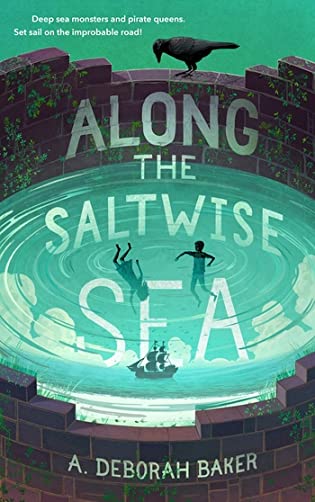 Flowers for the Sea by Zin E. Rocklyn
Flowers for the Sea by Zin E. Rocklyn Format: audiobook, eARC
Source: supplied by publisher via NetGalley
Formats available: paperback, ebook, audiobook
Pages: 112
Published by Tordotcom on October 19, 2021
Purchasing Info: Author's Website, Publisher's Website, Amazon, Barnes & Noble, Kobo, Bookshop.org
Goodreads
Flowers for the Sea is a dark, dazzling debut novella that reads like Rosemary's Baby by way of Octavia E. Butler.
We are a people who do not forget.
Survivors from a flooded kingdom struggle alone on an ark. Resources are scant, and ravenous beasts circle. Their fangs are sharp.
Among the refugees is Iraxi: ostracized, despised, and a commoner who refused a prince, she’s pregnant with a child that might be more than human. Her fate may be darker and more powerful than she can imagine.
Zin E. Rocklyn’s extraordinary debut is a lush, gothic fantasy about the prices we pay and the vengeance we seek.
My Review:
I picked this up because I was expecting a story that would be doing that creepy, uncomfortable straddle over the place where dark fantasy bleeds into horror. But that wasn’t quite what I got – although there was plenty of uncomfortable, downright painful straddling in the book itself.
Having finished the book, it feels like I got the middle part of a story that had a lot more depth to explore – but that those deeper elements just weren’t present in the part I got.
The story begins aboard a ship that has, or at least had, some very interesting magic. The ship is and has been, floating in an endless sea, its passengers permanent exiles from a shore they left behind. Originally, the ship fed and protected and sustained them easily, but the magic is dying, or the sea is dying, or it’s all fading away.
Our perspective on the ship, its inhabitants and its circumstances is through the mind of resentful, pregnant, angry, ostracized Iraxi. She is angry at everyone on the ship, and everyone on the ship is resentful and afraid of her. Even though they all hope that the baby she has zero desire to carry or bear will save them all.
Iraxi’s perspective is an uncomfortable one. She is, herself, extremely uncomfortable in the last days of her pregnancy, and very, very angry at everyone and everything around her. Including most especially, herself.
But Iraxi’s anger is a much bigger thing than one woman – or even one ocean – can contain. All she has to do is accept it, and accept the past that brought her to this point, and it will become big enough to encompass the world – and destroy it.
 Escape Rating C: Even after finishing this book, I still had more of a sense of what it was supposed to be from the blurb than from reading – actually listening to – the entire thing from beginning to end. Not that the reader didn’t do a good job, because she most definitely did, but because the story didn’t quite gel for me – or perhaps it gelled in the wrong places.
Escape Rating C: Even after finishing this book, I still had more of a sense of what it was supposed to be from the blurb than from reading – actually listening to – the entire thing from beginning to end. Not that the reader didn’t do a good job, because she most definitely did, but because the story didn’t quite gel for me – or perhaps it gelled in the wrong places.
The blurb describes Flowers for the Sea as Rosemary’s Baby meets Octavia Butler, in other words a combination of horror and SF. I was expecting something at least a bit like Rivers Solomon’s marvelous The Deep, in the sense that I was expecting a story that was intended to reclaim the Middle Passage of the slave trade for its victims and away from its perpetrators.
I didn’t exactly get either of those things. Admittedly that’s at least in part because both the author and the narrator did an all too excellent job of portraying Iraxi’s unwanted, undesired, unwelcome and utterly resented pregnancy and eventual childbirth as a internal horror of anger, fear, hatred, loathing, disgust and pretty much every other negative emotion in a way that hit me right in the nightmare to the point where it overshadowed the entire story.
The other reason the story didn’t gel is that we see the entire thing from Iraxi’s perspective, and Iraxi is angry almost to the point of incoherence pretty much all of the time. She hates her circumstances, she hates her pregnancy, she hates her baby, she hates all the people aboard the ship for the way that they have forced her to carry this unwanted pregnancy to term, the way that they in their turn hate and fear her and only give a damn about the child she is carrying. She’s lonely, she’s resentful, she’s afraid and she’s hiding the reasons she is in this circumstance from herself and from the reader, only dribbling out clues and then shutting herself down before we learn what we need to know.
Paradoxically for a story that didn’t work for me, I wish this had been longer. We don’t know anything about this world, although we learn that it isn’t exactly ours. We don’t know nearly enough about Iraxi’s people, their background or how they got into this fix. We eventually get hints, but they’re not enough. More pages, more scope to learn more, would have made this work better – at least for this reader.
Your reading mileage may vary. I’m headed off to gibber in a quiet corner someplace until the nightmare passes.

 Sisters of the Great War by
Sisters of the Great War by 
 Fan Fiction: A Mem-Noir: Inspired by True Events by
Fan Fiction: A Mem-Noir: Inspired by True Events by 
 A Line To Kill (Hawthorne and Horowitz Mystery, #3) by
A Line To Kill (Hawthorne and Horowitz Mystery, #3) by  After the previous books in this series,
After the previous books in this series,  Escape Rating B+: Both of the author’s current series, the
Escape Rating B+: Both of the author’s current series, the  The thing is, Tony doesn’t actually like Hawthorne, which is fair, because Hawthorne is not at all likeable. It makes the early part of this book awkward because all of their interactions are frustrating, and Tony is clearly frustrated by pretty much everything involved in his odd relationship with Hawthorne. Absent a case, their conversations seem rather forced – only because they are. But it makes for a bit of a slow read until they have a case in hand.
The thing is, Tony doesn’t actually like Hawthorne, which is fair, because Hawthorne is not at all likeable. It makes the early part of this book awkward because all of their interactions are frustrating, and Tony is clearly frustrated by pretty much everything involved in his odd relationship with Hawthorne. Absent a case, their conversations seem rather forced – only because they are. But it makes for a bit of a slow read until they have a case in hand.

 Current Giveaways:
Current Giveaways: Blog Recap:
Blog Recap:




















 The Route of Ice and Salt by
The Route of Ice and Salt by  (If you haven’t read the original, it’s available in
(If you haven’t read the original, it’s available in Escape Rating A-: Dracula may be the entry point for this story for many readers, but the Count isn’t exactly THE point of the story. The Route of Ice and Salt is cult classic of Mexican fantasy, first published in 1998 by a small comic book publisher that didn’t survive its attempt to jump from comic books to prose. This is the first translation of the work into English, and it’s a creeping fever dream of a story that picks up on themes that were subtext in Dracula – and other early vampire stories – and moves them from subtext to explicit text.
Escape Rating A-: Dracula may be the entry point for this story for many readers, but the Count isn’t exactly THE point of the story. The Route of Ice and Salt is cult classic of Mexican fantasy, first published in 1998 by a small comic book publisher that didn’t survive its attempt to jump from comic books to prose. This is the first translation of the work into English, and it’s a creeping fever dream of a story that picks up on themes that were subtext in Dracula – and other early vampire stories – and moves them from subtext to explicit text. Scandal in Babylon by
Scandal in Babylon by 
 The Hacker (Norcross Security #5) by
The Hacker (Norcross Security #5) by  One of the things I love about this author’s series (serieses?) is the way that each book in the series previews the coming attractions of the romance in the next book. So the genesis of The Hacker was foreshadowed at the end of
One of the things I love about this author’s series (serieses?) is the way that each book in the series previews the coming attractions of the romance in the next book. So the genesis of The Hacker was foreshadowed at the end of  Escape Rating B: The Hacker is a solidly entertaining entry in the
Escape Rating B: The Hacker is a solidly entertaining entry in the  Along the Saltwise Sea (The Up-and-Under, #2) by
Along the Saltwise Sea (The Up-and-Under, #2) by  In their own ways, at the beginning of the first book in
In their own ways, at the beginning of the first book in  But very little happens – at least until the very end when suddenly a lot happens all at once, a bit of how the world works gets explained, and the Improbable Road finds them again and whisks them off to more adventure.
But very little happens – at least until the very end when suddenly a lot happens all at once, a bit of how the world works gets explained, and the Improbable Road finds them again and whisks them off to more adventure.